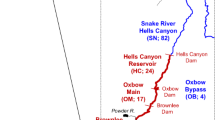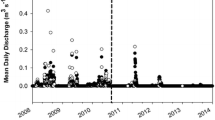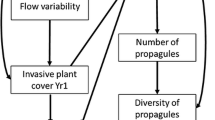Abstract
We investigated interactions between river regulation, riparian black cottonwoods (Populus trichocarpa) and beavers (Castor canadensis) with a paired comparison between the free-flowing Lardeau River and regulated lower Duncan River in western Canada. Cottonwood saplings occurred more broadly along Lardeau River transects (63 % vs. 38 %) and with increased density. Beavers preferred cottonwoods over other shrubs and cutting was more intense (36 % vs. 7 % of stems cut) along the regulated Duncan River. Beaver cutting occurred in wider bands (25 m vs. 11 m from river) along the Duncan, and there was also evidence for increased cutting of a less-favored alternate, alder (Alnus incana), while willows (Salix spp.) were substantially cut along both rivers. River regulation has apparently reduced cottonwood recruitment along the Duncan River and regulation may also increase beaver accessibility to saplings since higher river levels in late summer and autumn may promote inland access. These ecosystem alterations may thus create an imbalance between bottom-up cottonwood recruitment versus top-down mortality. We overview some of the ecological interactions in riparian woodlands in a schematic model recognizing river flow regime, sediment patterns and bank forms, and other riparian vegetation as key factors influencing cottonwoods and beavers.






Similar content being viewed by others
References
Andersen DC, Cooper DJ (2000) Plant-herbivore-hydro period interactions: effects of native mammals on floodplain tree recruitment. Ecol Appl 10:1384–1399
Bailey JK, Whitham TG (2006) Interactions between cottonwood and beavers positively affect sawfly abundance. Ecol Entomol 31:294–297
Baker BW (2003) Beaver (Castor canadensis) in heavily browsed environments. Lutra 46:173–181
Basey JM, Jenkins SH, Busher PE (1998) Tree-size selection in relation to defensive chemicals of quaking aspen. Oecologia 2:278–282
Benjankar R, Burke M, Yager E, Tonina D, Egger G, Rood SB, Merz N (2014) Development of a spatially-distributed hydroecological model to simulate cottonwood seedling recruitment along rivers. J Environ Manag 145:277–288
Braatne JH, Jamieson R, Gill KM, Rood SB (2007) Instream flows and the decline of riparian cottonwoods along the Yakima river, Washington, USA. River Res Appl 23:247–267
Braatne JH, Rood SB, Goater LA, Blair CL (2008) Analyzing the impacts of dams on riparian ecosystems: a review of research strategies and their relevance to the snake river through hells canyon. Environ Manag 41:267–281
Bradley CE, Smith DG (1986) Plains cottonwood recruitment and survival on a prairie meandering river floodplain, milk river, southern Alberta and northern Montana. Can J Bot 64:1433–1442
Breck SW, Wilson KR, Andersen DC (2001) The demographic response of bank-dwelling beavers to flow regulation: a comparison on the green and Yampa rivers. Can J Zool 79:1957–1964
Breck SW, Wilson KR, Andersen DC (2003a) Beaver herbivory and its effect on cottonwood trees: influence of flooding along matched regulated and unregulated rivers. River Res Appl 19:43–58
Breck SW, Wilson KR, Andersen DC (2003b) Beaver herbivory of willow under two flow regimes: a comparative study on the green and Yampa rivers. West North Am Nat 63:463–471
Cunningham JM, Calhoun AJK, Glanz WE (2006) Pond-breeding amphibian species richness and habitat selection in a beaver-modified landscape. J Wildl Manag 71:2517–2526
Gallant D, Berube CH, Tremblay E, Vasseur L (2004) An extensive study of the foraging ecology of beavers (Castor canadensis) in relation to habitat quality. Can J Zool 82:922–933
Green K, Westbrook CJ (2009) Changes in riparian area structure, channel hydraulics, and sediment yield following loss of beaver dams. BC J Ecosystems Manag 10:68–79
Gurnell AM (1998) The hydrogeological effects of beaver dam-building activity. Prog Phys Geogr 22:167–189
Hay KG (1958) Beaver census methods in the rocky mountain region. J Wildl Manag 22:395–402
Herbison B, Polzin ML, Rood SB (2015) Hydration as a possible colonization cue: rain may promote seed release from black cottonwood trees. For Ecol Manag 350:22–29
Hood GA, Bayley SE (2008a) Beaver (Castor canadensis) mitigate the effects of climate on the area of open water in boreal wetlands in western Canada. Biol Conserv 141:556–567
Hood GA, Bayley SE (2008b) The effects of high ungulate densities on foraging choices by beaver (Castor canadensis) in the mixed-wood boreal forest. Can J Zool 86:484–496
Hood GA, Larson DG (2015) Ecological engineering and aquatic connectivity: a new perspective from beaver-modified wetlands. Freshw Biol 60:198–208
Hughes FM (1997) Floodplain biogeomorphology. Prog Phys Geogr 21:501–529
Kalischuk AR, Rood SB, Mahoney JM (2001) Environmental influences on seedling growth of cottonwoods species following a major flood. For Ecol Manag 144:75–89
Lesica P, Miles S (2004) Beavers indirectly enhance the growth of Russian olive and tamarisk along eastern Montana rivers. West North Am Nat 64:93–100
Luttmerding HA, Demarchi DA, Lea EC, Meidinger DV, Vol T (1998) Field manual for describing terrestrial ecosystems. Land Management Handbook No 25. BC Ministry of Environment, Lands and Parks and BC Ministry of Forests, Victoria, BC
McTaggart ST, Nelson TA (2003) Composition and demographics of beaver (Castor canadensis) colonies in central Illinois. Am Midl Nat 150:139–150
Merritt DM, Cooper DJ (2000) Riparian vegetation and channel change in response to river regulation: a comparative study of regulated and unregulated streams in the green river basin. Regul Rivers Res Manag 86:543–564
Miles M (2002) Channel stability assessment of the lower Duncan river. Report for BC Hydro, Southpoint Drive, Burnaby, BC
Naiman RJ, Décamps JH, McCain MC (2005) Riparia. Academic Press, San Diego, U.S.A
Naiman RJ, Johnston CA, Kelly JC (1988) Alteration of north American streams by beaver. Bioscience 38:753–762
Naiman RJ, Rogers KH (1997) Large animals and system-level characteristics in river corridors: implications for river management. Bioscience 47:521–529
Northcott TH (1971) Feeding habits of beaver in newfoundland. Oikos 22:407–410
Novak M (1977) Determining the average size and composition of beaver families. J Wildl Manag 41:751–754
Parker JD, Caudill CC, Hay ME (2007) Beaver herbivory on aquatic plants. Oecologia 151:616–625
Pastor J, Naiman RJ (1992) Selective foraging and ecosystem processes in boreal forests. Am Nat 139:690–705
Pollock MM, Beechie TJ, Wheaton JM, Jordan CE, Bouwes N. Weber N, Volk C (2014). Using beaver dams to restore incised stream ecosystems. Bioscience 64: 279–290.
Polzin ML, Herbison B, Gill KM, Rood SB (2010) DDMMON #8–1 lower Duncan river riparian cottonwood monitoring program. Year 1 annual report – 2009. For BC Hydro Generations, Castlegar, BC, p. pp110
Polzin ML, Rood SB (2000) Effects of damming and flow stabilization on riparian processes and black cottonwoods along the Kootenay river. Rivers 7:221–232
Polzin ML, Rood SB (2006) Effective disturbance: seedling safe sites and patch recruitment of riparian cottonwoods after a major flood of a mountain river. Wetlands 26:965–980
Raffel TR, Smith N, Corthright C, Gatz AJ (2009) Central place foraging by beavers (Castor canadensis) in a complex lake habitat. Am Midl Nat 162:62–73
Ripple WJ, Beschta RL (2003) Wolf reintroduction, predation risk and cottonwood recovery in Yellowstone national park. For Ecol Manag 154:292–313
Rood SB, Bigelow SG, Polzin ML, Gill KM, Coburn CA (2015) Biological bank protection: trees are more effective than grasses at resisting erosion from major river floods. Ecohydrology. doi:10.1002/eco.1544
Rood SB, Braatne JH, Goater LA (2010) Responses of obligate versus facultative riparian shrubs following river damming. River Res Appl 26:102–117
Rood SB, Goater LA, Gill KM, Braatne JH (2011) Sand and sandbar willow: a feedback loop amplifies environmental sensitivity at the riparian interface. Oecologia 165:31–40
Rood SB, Kalischuk AR, Polzin ML, Braatne JH (2003) Branch propagation, not cladoptosis, permits dispersive, clonal reproduction of riparian cottonwoods. For Ecol Manag 186:227–242
Rood SB, Mahoney JM (2000) Revised instream flow regulation enables cottonwood recruitment along the St. Mary river, Alberta, Canada. Rivers 7:109–125
Rood SB, Pan J, Gil KM, Franks CG, Samuelson GM, Shepherd A (2008) Declining summer flows of rocky mountain rivers: historic hydrology and probable impacts on floodplain forests. J Hydrol 349:397–410
Rosell F, Bozser O, Collen P, Parker H (2005) Ecological impacts of beaver Castor fiber and Castor canadensis and their ability to modify ecosystems. Mammal Rev 35:248–276
Scott MT, Auble GT, Freidman JM (1997) Flood dependency of cottonwood establishment along the Missouri river, Montana, USA. Ecol Appl 7:677–690
Seavey N, Gardali T, Golet G, Grigs T, Howell R, Small S (2009) Why climate change makes riparian restoration more important than ever: recommendations for practice and research. Ecol Restor 27:330–338
Sun L, Muller-Schwarze D (1998) Anal gland secretion codes for relatedness in the beaver, Castor canadensis. Ethology 104:917–927
Svendsen GE (1980) Seasonal changes in feeding patterns of beaver in southeastern Ohio. J Wildl Manag 44:285–290
Svendsen GE (1978) Castor and anal glands of the beaver (Castor canadensis). J Mammal 59:618–620
Tiedemann RB, Rood SB (2015) Flood flow attenuation diminishes cottonwood colonization sites: an experimental test along the Boise river. USA Ecohydrology. doi:10.1002/eco.1619
Tockner K, Lorang MS, Stanford JA (2010) River flood plains are model ecosystems to test general hydrogeomorphic and ecological concepts. River Res Appl 26:76–86
Wright PW, Jones CG, Flecker AS (2002) An ecosystem engineer, the beaver, increases species richness at the landscape scale. Oecologia 132:96–101
Acknowledgments
We thank John Mahoney (Alberta Environment, Lethbridge) for his valuable inputs, Karen Zanewich (Univ. Lethbridge) for assistance with the manuscript, and BC Hydro and Mary Louise Polzin (Vast Resources) for allowing the use of overlapping results from the Duncan Dam monitoring program. Funding support to S. Rood was provided by the Natural Sciences and Engineering Council (NSERC) of Canada and Alberta Innovates – Energy and Environmental Solutions.
Author information
Authors and Affiliations
Corresponding author
Rights and permissions
About this article
Cite this article
Herbison, B., Rood, S.B. Compound Influences of River Damming and Beavers on Riparian Cottonwoods: A Comparative Study Along the Lardeau and Duncan Rivers, British Columbia, Canada. Wetlands 35, 945–954 (2015). https://doi.org/10.1007/s13157-015-0685-8
Received:
Accepted:
Published:
Issue Date:
DOI: https://doi.org/10.1007/s13157-015-0685-8




